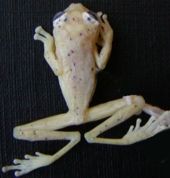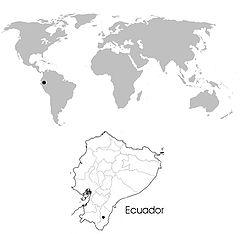- Centrolene mariaelenae
-
Centrolene mariaelenae 
Photo of the holotype, only specimen known Scientific classification Kingdom: Animalia Phylum: Chordata Class: Amphibia Order: Anura Family: Centrolenidae Genus: Centrolene Species: C. mariaelenae Binomial name Centrolene mariaelenae
Cisneros-Heredia & McDiarmid, 2006Distribution of Centrolene mariaelenae in a global and Ecuadorian perspective. A species of Centrolene described in 2006 from the southeastern Andean slopes of Ecuador. This taxon remains known from a few specimens across central and southern Ecuador[1],[2].
Contents
Type locality
Collected along a small stream, tributary of the Jambue River, ca. 16 km S from Zamora, Podocarpus National Park (ca. 04º15’S, 78º56’W, 1820 m), on the western slope of Contrafuerte de Tzunantza, Cordillera Oriental, eastern slopes of the Andes, Provincia de Zamora-Chinchipe, Republic of Ecuador.
Diagnostic characters
Centrolene mariaelenae is diagnosed from other species of the family Centrolenidae by the combination of the following characters: (1) vomerine teeth absent; (2) bones white in preservative (unknown in life); (3) parietal peritoneum clear without guanophores in a bib-like fashion; guanophores covering on the pericardial, hepatic and visceral peritonea, except for the clear gall bladder; (4) color in preservative, dorsal and flank surfaces cream with many small dark lavender punctuations and scattered larger dark flecks; (5) webbing absent between fingers I and II, basal between fingers II and III, outer fingers III2½-2½IV; (6) webbing on feet I2-–2½II2-3III2-3IV2b-1bV; (7) snout bluntly truncate in dorsal view and truncate in profile; notch in lower lip absent; nostrils elevated, indentation between the nostrils; loreal region concave; (8) dorsal skin shagreen; (9) no dermal folds on hands, forearms, feet, or tarsus; (10) humeral spine present in male holotype; (11) tympanum oriented posterolaterally with light dorsal inclination; tympanic annulus rather indistinct; supratympanic fold weak; (12) snout-vent length in male holotype 19.0 mm; females unknown; (13) prepollical spine not protruding externally; unpigmented nuptial excrescence Type I; (14) pair of large, round, flat tubercles on ventral surfaces of thighs below vent; other anal ornamentation absent, ventral skin granular and not enameled; (15) first finger longer than second, (16) liver apparently bulbous (but see Discussion); (17) eye diameter larger than width of disc on finger III; (18) iris grey in preservative; (19) melanophores absent on fingers and toes except for a few at the base of Toe V; (20) the advertisement call is unknown for this species.
Species group
Centrolene mariaelenae belong to the Centrolene gorzulai species-group in accord to the original description.
Etymology of the specific name Centrolene mariaelenae
The specific name of C. mariaelenae is a noun in the genitive case and a patronym for María Elena Heredia, mother of one of the authors of the description of the species.
Distribution
Centrolene mariaelenae is known from a few specimens collected in the province of Zamora-Chinchipe, Tungurahua, and Orellana, Ecuador. The type specimen was collected in a stream in old secondary-growth Low Montane Evergreen Forest at 1800 m elevation. The small stream is tributary of the Jambue River on the western slope of the Contrafuerte (Cordillera) de Tzunantza, a ridge part of the Cordillera Oriental (Cordillera Real), southeastern Ecuadorian Andes.
References
All information in this account is taken from:
- ^ Cisneros-Heredia, D.F. & McDiarmid, R.W. (2006). A new species of the genus Centrolene (Amphibia: Anura: Centrolenidae) from Ecuador with comments on the taxonomy and biogeography of Glassfrogs. Zootaxa 1244: 1-32 - Description of Centrolene mariaelenae. (PDF of the abstract available by clicking here)
- ^ Cisneros-Heredia, D.F. & Guayasamin, J.M. (2006). Amphibia, Anura, Centrolenidae, Centrolene mariaelenae: Distribution extension, Ecuador. Check List 2(3): 93-95. - Expansion on the distribution of Centrolene mariaelenae in Ecuador. (PDF of the abstract available by clicking here)
Categories:- Centrolene
- Amphibians of Ecuador
Wikimedia Foundation. 2010.

